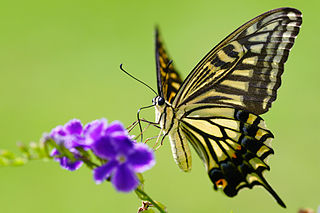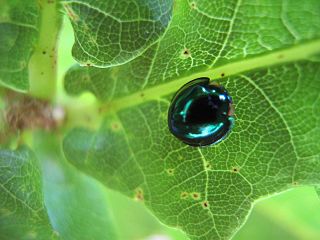
The butterflies of New Zealand include twelve endemic species, as well as several introduced and migrant species. Lepidoptera, which includes the butterflies and moths, is the third largest insect order in New Zealand.

The butterflies of New Zealand include twelve endemic species, as well as several introduced and migrant species. Lepidoptera, which includes the butterflies and moths, is the third largest insect order in New Zealand.




| Scientific name | Local English name [1] | Māori name [1] | Native/introduced/migrant [1] | Conservation status [2] |
|---|---|---|---|---|
| Catopsilia pomona (Fabricius, 1775) | lemon emigrant | very rare migrant | ||
| Pieris rapae (Linnaeus, 1758) | white butterfly | pepe mā | introduced | |
| Lycaena boldenarum White, 1862 | boulder copper | pepe para riki | native, endemic | |
| Lycaena salustius (Fabricius, 1793) | common copper | pepe para riki | native, endemic | |
| Lycaena feredayi (Bates, 1867) | glade copper | pepe para riki | native, endemic | |
| Lycaena rauparaha (Fereday, 1877) | Rauparaha's copper | mokarakare | native, endemic | |
| Lampides boeticus (Linnaeus, 1767) | long-tailed blue | native (self-introduced) | ||
| Zizina otis labradus (Godart, 1824) | common blue | pepe ao uri | native or possibly introduced | |
| Zizina oxleyi (C. & R. Felder, 1865) | southern blue | native, endemic | ||
| Tirumala hamata hamata (MacLeay, 1826) | Australian blue tiger | very rare migrant | ||
| Danaus plexippus (Linnaeus, 1758) | monarch | kahuku | native (self-introduced) | |
| Danaus petilia (Stoll, 1790) | lesser wanderer | rare migrant | ||
| Junonia villida calybe Godart, 1819 | Australian meadow argus | very rare migrant | ||
| Hypolimnas bolina nerina (Fabricius, 1775) | blue moon | regular migrant | ||
| Vanessa itea (Fabricius, 1775) | yellow admiral | kahu kōwhai | native | |
| Vanessa gonerilla gonerilla (Fabricius, 1775) | [New Zealand] red admiral | kahu kura | native, endemic | |
| Vanessa gonerilla ida (Alfken, 1899) | Chatham Island red admiral | kahu kura | native, endemic | |
| Vanessa kershawi (McCoy, 1868) | Australian painted lady | pepe parahua | regular migrant | |
| Melanitis leda bankia (Fabricius, 1775) | evening brown | very rare migrant | ||
| Percnodaimon merula (Hewitson, 1875) | black mountain ringlet | pepe pouri | native, endemic | |
| Erebiola butleri Fereday, 1879 | Butler's ringlet | pepe pouri | native, endemic | |
| Dodonidia helmsii Butler, 1884 | forest ringlet | pepe pouri te pēpepe pōuri | native, endemic | serious decline |
| Argyrophenga antipodum Doubleday, 1845 | common tussock | native, endemic | ||
| Argyrophenga harrisi Craw, 1978 | Harris's tussock | native, endemic | ||
| Argyrophenga janitae Craw, 1978 | Janita's tussock | native, endemic |
Very little is known about any butterfly extinctions since human settlement of New Zealand since they leave few remains. The majority of New Zealand invertebrates are found in forests, so it is possible that some butterflies became extinct due to the large scale forest clearance after human settlement. [3]
Apart from the rare but consistent sightings of Australian migrant butterflies, several other species have also been recorded on the island over the years.
| Species | Location(s) | Date | Method of introduction |
|---|---|---|---|
| Small tortoiseshell (Aglais urticae) | Lincoln, Canterbury | 13 August 2019 [4] | Unknown |
| Blue triangle (Graphium choredon) | Prebbleton, Canterbury | 15 March 2017 | Unknown/wind current |
| Asian swallowtail (Papilio xuthus) | Dunedin, Auckland | 1996, 2011, 2016 [5] | Importation of citrus trees, importation of cars |
| Black Jezebel (Delias nigrina) | Waikaia, Southland | January 2010 [6] | Unknown/wind current |
| Common Mormon (Papilio polytes) | Westshore, Hawkes Bay | 22 January 2014 [7] | Likely importation of citrus/curry leaf plants |

The small tortoiseshell (Aglais urticae), which is a butterfly native to Eurasia, was spotted near Lincoln University, Canterbury, on 13 August 2019, though the method of its introduction remains unknown. [4]

The blue triangle (Graphium choredon), most likely from Australia, appeared in a Prebbleton garden feeding on aster flowers on 15 March 2017, likely carried by wind currents. [8]

The Asian swallowtail (Papilio xuthus) has been recorded in Dunedin in 1996, when a pupa emerged on a car which had recently been imported from Japan. Two further sightings were made in Auckland in 2011 and 2016, likely from the importation of citrus trees. [9]

The black Jezebel (Delias nigrina) was seen in Waikaia, Southland, after it was rescued from a spider web in January 2010, with its arrival also attributed to wind currents or unknown factors. [10]

The common Mormon (Papilio polytes) was seen in the Westshore suburb of Napier, Hawke's Bay on 22 January 2014. The specimen resembled subspecies from Malaysia and Hong Kong. It is attributed to shipping of citrus or curry leaf plants. [7]

Other species of Lepidoptera, such as saturniid moths have been sighted due to similar causes.

The small tortoiseshell is a colourful Eurasian butterfly in the family Nymphalidae. Adults feed on nectar and may hibernate over winter; in warmer climates they may have two broods in a season. While the dorsal surface of the wings is vividly marked, the ventral surface is drab, providing camouflage. Eggs are laid on the common nettle, on which the larvae feed.

The large tortoiseshell or blackleg tortoiseshell is a butterfly of the family Nymphalidae.

The forest ringlet, also known as Helms' butterfly, or te pēpepe pōuri or pepe pouri in the Māori language, is a rare butterfly of the family Nymphalidae endemic to New Zealand. It is the only species in the genus Dodonidia.

The eastern giant swallowtail is the largest butterfly in North America. It is abundant through many parts of eastern North America; populations from western North America and down into Panama are now considered to belong to a different species, Papilio rumiko. Though it is often valued in gardens for its striking appearance, its larval stage can be a serious pest to citrus farms, which has earned its caterpillars the names orange dog or orange puppy. The eastern giant swallowtail caterpillars possess remarkable camouflage from predators by closely resembling bird droppings. They use this, along with their osmeteria, to defend against predators such as wasps, flies, and vertebrates.

Nymphalini is a tribe of nymphalid brush-footed butterflies. Common names include admirals, anglewings, commas, and tortoiseshells, but none of these is specific to one particular genus.

Urtica urens, commonly known as annual nettle, dwarf nettle, small nettle, dog nettle, or burning nettle, is a herbaceous annual flowering plant species in the nettle family Urticaceae. It is native to Eurasia, including the Himalayan regions of Kalimpong, Darjeeling and Sikkim in India and can be found in North America, New Zealand and South Africa as an introduced species. It is reputed to sting more strongly than common nettle.

Papilio xuthus, the Asian swallowtail, Chinese yellow swallowtail, Japanese Swallowtail, or Xuthus swallowtail, is a yellow-colored, medium to large sized swallowtail butterfly found in northeast Asia, northern Myanmar, southern China, Taiwan, the Korean Peninsula, Japan, Siberia and the Hawaiian Islands. The butterfly has been observed thrice in New Zealand. Once in Dunedin in 1996 emerging from a chrysalis in a car yard specializing in Japanese used cars; it is thought the chrysalis arrived through one of the cars. and later in Auckland in 2011 and 2016. It was also recorded in the state of Arunachal Pradesh, India, in 2014.

Halmus chalybeus, commonly known as the steelblue ladybird, is a species of ladybird native to Australia. It has a rounded appearance with an iridescent blue/green colouration and is a predator of other insects. It was introduced to New Zealand from Australia in 1899 and 1905 to control black scale and blue gum scale on citrus trees, where it is now common in northern regions. It has also been recorded eating San Jose scale. They are about 3–4 mm long.

Xanthocryptus novozealandicus, the lemon tree borer parasite, is a wasp in the family Ichneumonidae. It is a native insect of New Zealand. It is also found in Australia and New Guinea. Females hunt for larvae of wood-boring beetles around March, including the lemon tree borer, a native cerambycid that tunnels into citrus trees, grapes and many native species. When a suitable host is found, the female pushes her ovipositor through the wood and injects her eggs into the grub. This has the incidental benefit of helping to control some pests. X. novozealandicus prefers to prey on second year lemon tree borer larvae. This specific parasite prefers to prey on larger second year larvae due to its larger size.
In the 10th edition of Systema Naturae, Carl Linnaeus classified the arthropods, including insects, arachnids and crustaceans, among his class "Insecta". Butterflies and moths were brought together under the name Lepidoptera. Linnaeus divided the group into three genera – Papilio, Sphinx and Phalaena. The first two, together with the seven subdivisions of the third, are now used as the basis for nine superfamily names: Papilionoidea, Sphingoidea, Bombycoidea, Noctuoidea, Geometroidea, Tortricoidea, Pyraloidea, Tineoidea and Alucitoidea.

Diasemia grammalis, also known as the Arrowhead, is a moth of the family Crambidae. It is likely endemic to New Zealand and has been observed in both the North and South Islands. The species inhabits open dry herb field areas. Adults are day flying and are on the wing most commonly from October until March. Larvae feed on the ground the roots of native grasses and shrubs including Muehlenbeckia axillaris.

Glaucocharis auriscriptella, also known as the yellow silverling, is a moth in the family Crambidae. It was first described by Francis Walker in 1864 and is endemic to New Zealand. This species can be found in the North, South, Stewart and Great Barrier Islands. The preferred habitat of this moth is lowland and subalpine native forest as well as wetlands. The larvae feed on moss. The adult moth is day flying and is on the wing from November to February. It can be observed in colonies and can be attracted to light at night. This species likely has only one generation per year.

Adeixis griseata is a species of moth of the family Geometridae. It is endemic to New Zealand and has been collected in the North, South and Chatham Islands. This species inhabits poorly drained or swampy areas. As at 2017 the host plant of this species is unknown however it has been hypothesised that the host plant may be Schoenus brevifolius or another common sedge. Adults have been observed on the wing from October until January.